Weblayers in scenarios
Weblayers in scenarios let you add website banners to your customer journey workflows. This creates a seamless experience across your website, email, and mobile campaigns. You can boost engagement, promote offers, and coordinate your messaging across all channels.
This article explains what weblayers in scenarios are and how to use them.
Before you start
To use this feature, you need the Bloomreach Engagement Web Personalization package for your project. Contact your Customer Success Manager (CSM) for activation.
Why use weblayers in scenarios
Adding weblayers to your scenarios offers three key advantages:
Improve customer engagement
- Show targeted messages at key points in the customer journey.
- Create compelling calls-to-action that influence customer behavior.
- Promote time-sensitive offers and collect survey data.
Create seamless cross-channel marketing
- Keep your messaging consistent across email, mobile, and web.
- Make sure customers see related content on any channel they use.
- Build a cohesive experience throughout the customer journey.
Run more effective campaigns
- See how customers move between different marketing channels.
- Create coordinated promotions for events like Black Friday.
- Reach customers who missed your emails when they visit your site.
How to add weblayer to scenarios
Follow these steps to add a weblayer to your scenario workflow:
- Go to Campaigns > Scenarios.
- To create a new scenario, click New Scenario.
- A pop-up appears. Click Create New Scenario.
- Under Actions, click Weblayer to add a weblayer node.
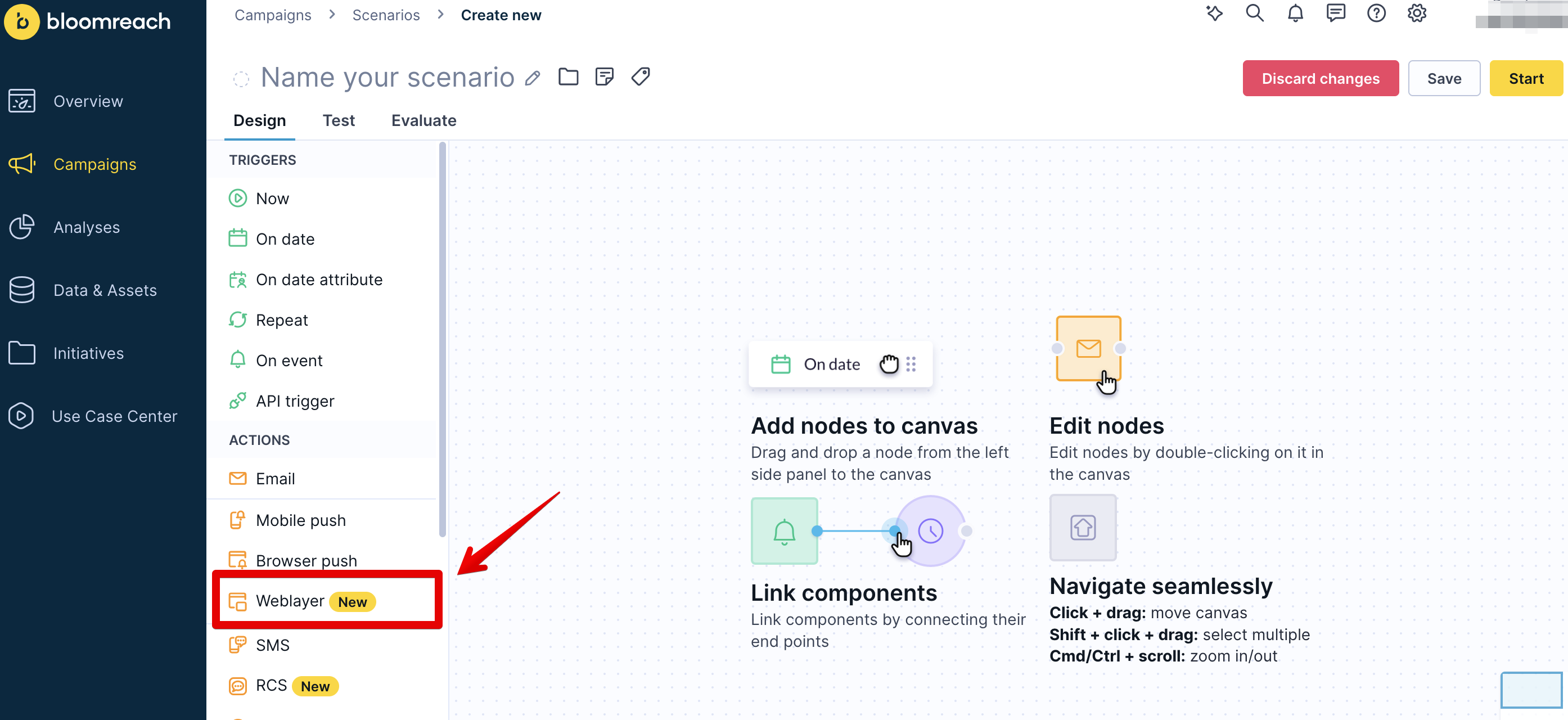
- Double-click the weblayer node to edit it.
- Choose your template:
- Blank template: Start with a completely empty weblayer
- Project templates: Use templates you've created for your project
- Predefined templates: Select from Bloomreach's ready-made templates
Note: Non-personalized weblayers aren't available in scenarios. This option is only available in standalone weblayer campaigns.
- Go to the Settings tab to configure your weblayer:
- Set your target audience in Entry criteria
- Adjust timing and display rules in Display settings
- Design your weblayer content in the Design tab.
- When you finish, click Save to confirm and save the changes.
Configure your weblayer
In the Settings tab, define your weblayer's audience, display rules, and performance settings. Unlike weblayers in campaigns, these only target users who reach this scenario node and can't expand beyond your scenario's original audience:
Entry criteria
Define who can see your weblayer using two filtering options:
Consent category
Show weblayers only to customers who've given specific types of consent. Choose from your existing consent categories or create custom ones based on your privacy requirements.
Customer filter
Narrow your audience further by adding conditions based on customer behavior, profile information, or funnel progress.
For example, target customers who abandoned their cart in the last 24 hours or VIP members in specific locations. Click + Add filter condition to set up these rules.
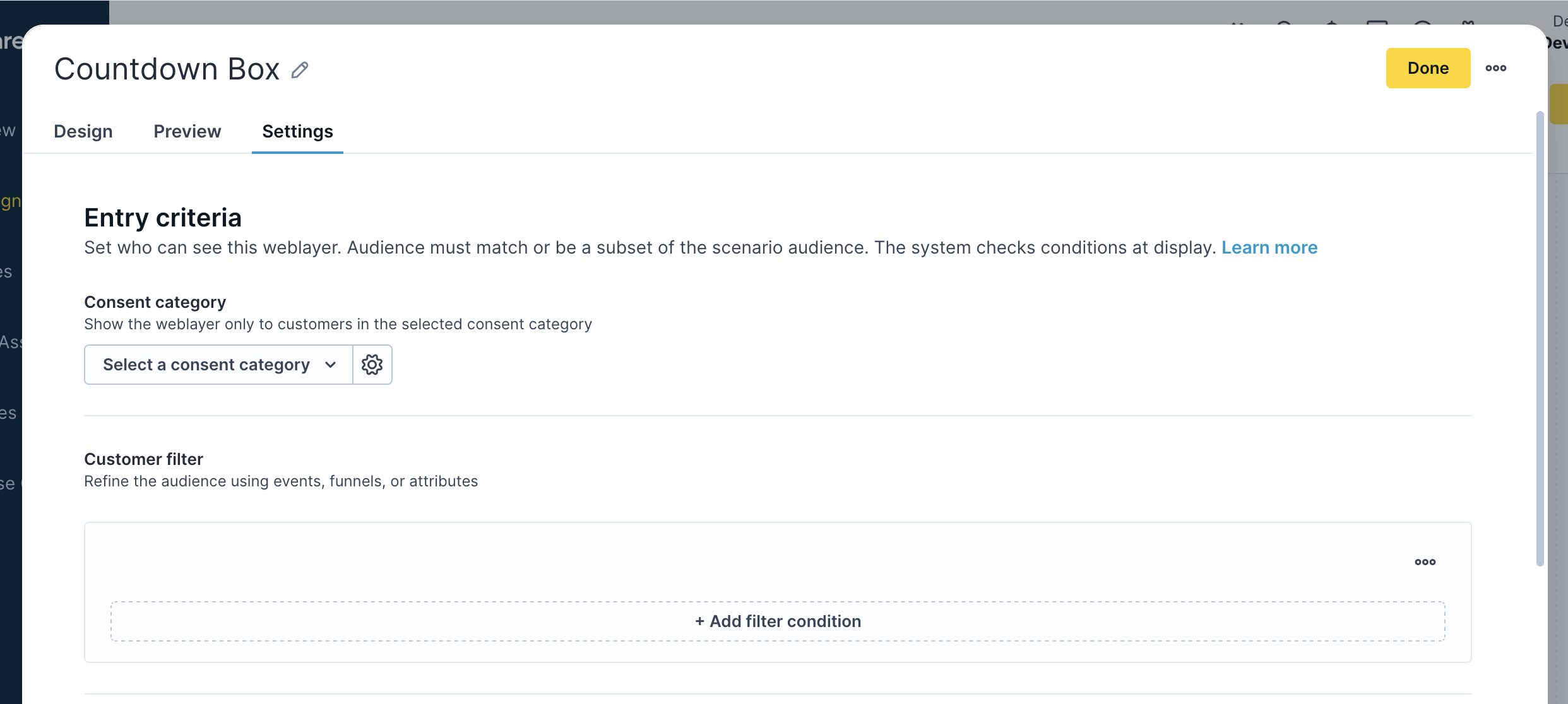
Display settings
Configure when and where your weblayer displays across your website:
Show on
Choose which pages display your weblayer. Select from options like all pages, specific URLs, or pattern matching. Use Add exception to exclude pages where weblayers might disrupt the user experience, such as checkout or login pages.
Show on pages with variables
Use page data to show different weblayers based on what's happening on the page.
For example, show different messages based on product categories or user behavior tracked through page variables.
Target devices
Choose whether to show your weblayer on desktop, mobile, or both types of devices. Choose desktop-only for detailed forms, mobile-only for app downloads, or both for universal messages.
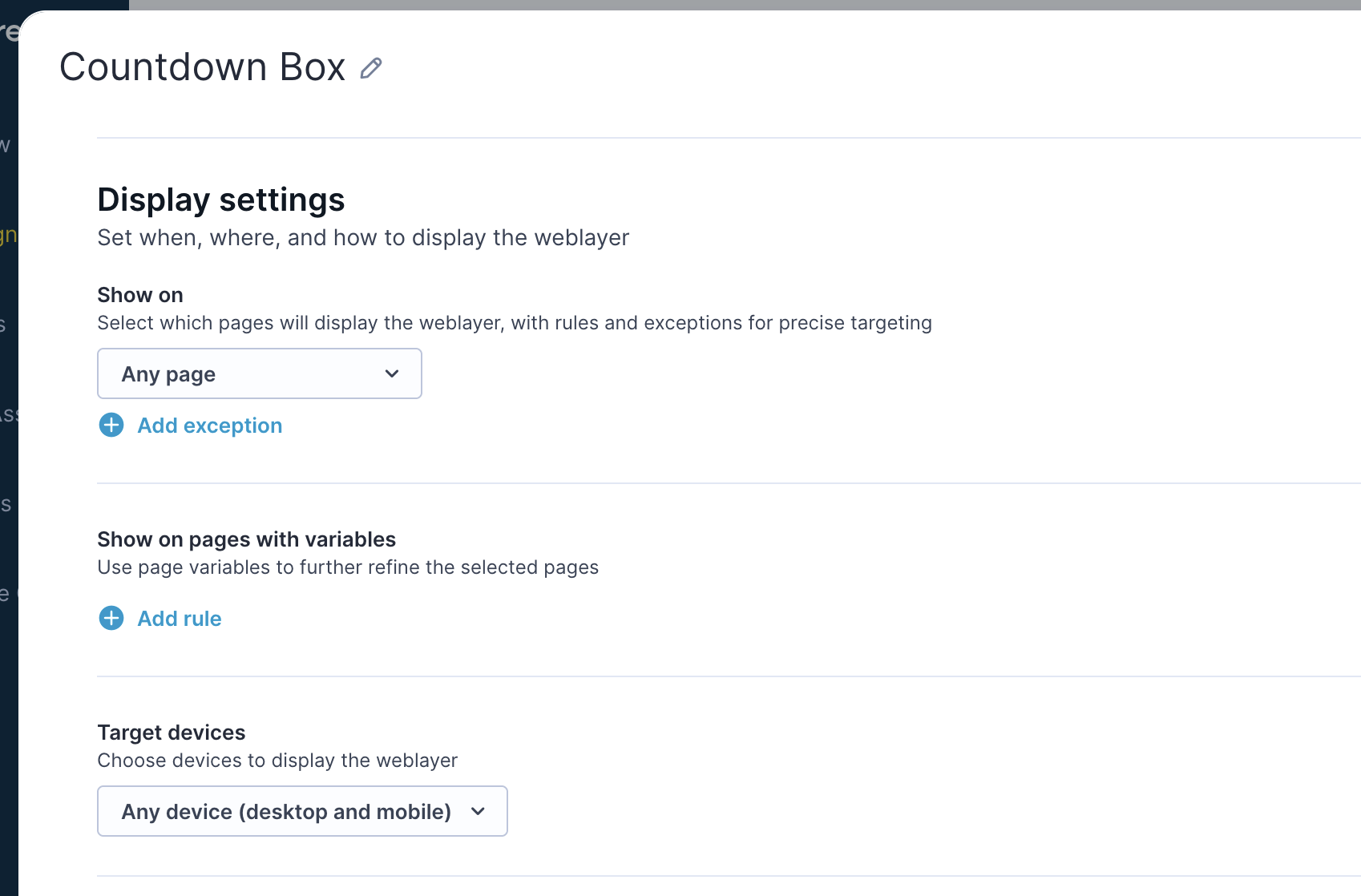
Display control
Control how often users see your weblayer to balance visibility with user experience:
- Always show: Best for critical announcements that need maximum exposure
- Once only: Ideal for welcome messages or one-time offers
- Once per visit: Good for session-based promotions without overwhelming return visitors
- Until interaction: Ensures your message stays visible until customers engage with it
Expiration control
Set when your weblayer stops displaying to keep content relevant:
- After conversion: Automatically hide the weblayer once customers complete your goal
- After specific date/time: Set exact end dates for time-sensitive campaigns
- After time period: Create urgency with countdown-based expiration
- After interaction: Remove the weblayer once customers click or engage
Conversion goal
Track your weblayer's success by selecting what counts as a conversion. Choose purchase events for sales-driven campaigns, custom events for specific actions like newsletter signups, or engagement metrics for awareness campaigns. This data helps measure your weblayer's impact on business objectives.
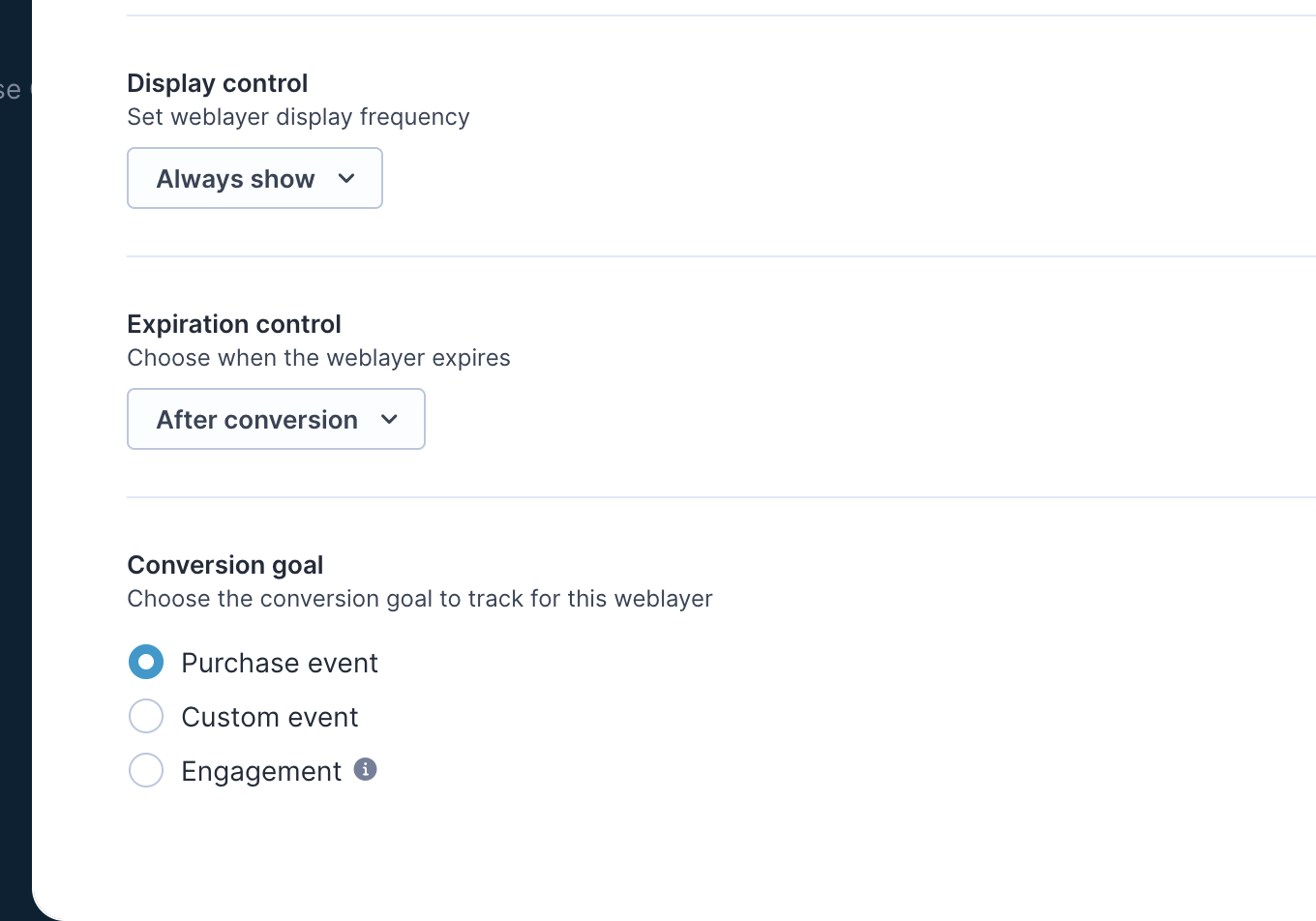
Understand the differences between weblayer types
Weblayers in scenarios work differently from standalone campaigns. Here are the key differences and how to work with the limitations:
| Feature | In scenarios | In campaigns |
|---|---|---|
| Creation | In Scenario editor | In Weblayers tab |
| Personalization | Available with consent | Available with consent |
| A/B testing | Use A/B test node instead | Built-in |
| Evaluation | Not available (use custom dashboards) | Built-in |
| Expiration control | Available | Available |
| Visibility | Linked to scenario only | Listed in Weblayers tab |
| Stop/start | Controlled through the scenario | Can pause individually |
Work around known limitations
- Can't control individual weblayers: You must start or stop the entire scenario.
- No built-in A/B testing: Use the A/B test node in your scenario instead.
- No Evaluate tab: Set up a custom dashboard to track performance.
- Manual enablement required: Ask your CSM to enable weblayers for your project.
- Limited visibility: Only accessible through the scenario where created.
A/B test weblayer variants
To compare different weblayer variants:
- Add an A/B test node in your scenario.
- Connect different weblayer nodes to each branch.
- Set your preferred percentage split.
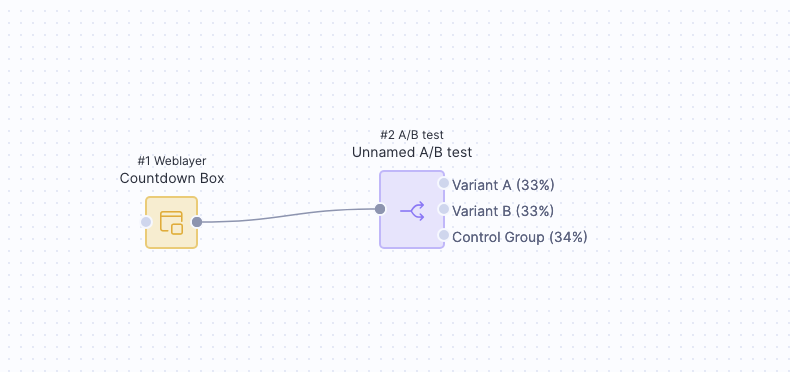
This approach lets you test different messages, designs, or targeting strategies within your scenario workflow.
Evaluate performance
Since weblayers in scenarios don't have a built-in Evaluate tab, you'll need to create a custom dashboard to track performance.
When a weblayer displays, the system generates a banner event with a campaign_id attribute that you can use for tracking. To evaluate your weblayer:
- Create a custom dashboard report using the
campaign_idfrom your weblayer - Include metrics like impressions, clicks, and conversions to measure impact on your business objectives
This approach gives you the flexibility to track the specific metrics that matter most for your campaign goals.
Use cases
Here are popular ways to use weblayers in scenarios:
Follow up on missed emails
- Show website offers to customers who didn't open your email.
- Give your promotions another chance to be seen.
Recover abandoned carts
- Display reminders when customers with items in cart return to your site.
- Highlight products they left behind.
Grow your audience and data
- Collect customer data by offering incentives through weblayers.
- Encourage newsletter sign-ups through special offers.
Create urgency
- Use countdown timers for sales and limited-time offers.
- Drive faster action by creating a sense of urgency.
Updated about 1 month ago
